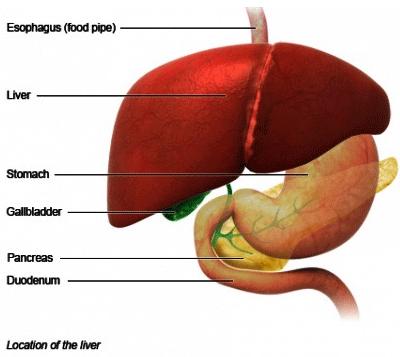The liver is the largest solid organ in the body. It removes toxins from the body’s blood supply, maintains healthy blood sugar levels, regulates blood clotting, and performs hundreds of other vital functions. It is located beneath the rib cage in the right upper abdomen.
- सूर्यदेव को प्रसन्न करने के लिए 12 नामों का करें जाप, रविवार को ऐसे करें पूजा
- अनुप्रास अलंकार – Anupras Alankar अनुप्रास अलंकार के 10 उदाहरण – Anupras Alankar Ke Udaharan
- Mother’s Day 2024: Date, history, significance and celebration
- गणतंत्र दिवस पर 10 वाक्य (10 Lines on Republic Day 2024 in Hindi)
- राजभाषा नियम, 1976 | राजभाषा विभाग | गृह मंत्रालय | भारत सरकार
Key Facts
- The liver filters all of the blood in the body and breaks down poisonous substances, such as alcohol and drugs.
- The liver also produces bile, a fluid that helps digest fats and carry away waste.
- The liver consists of four lobes, which are each made up of eight sections and thousands of lobules (or small lobes).
Functions of the Liver
The liver is an essential organ of the body that performs over 500 vital functions. These include removing waste products and foreign substances from the bloodstream, regulating blood sugar levels, and creating essential nutrients. Here are some of its most important functions:
Bạn đang xem: The Liver and Its Functions
- Albumin Production: Albumin is a protein that keeps fluids in the bloodstream from leaking into surrounding tissue. It also carries hormones, vitamins, and enzymes through the body.
- Bile Production: Bile is a fluid that is critical to the digestion and absorption of fats in the small intestine.
- Filters Blood: All the blood leaving the stomach and intestines passes through the liver, which removes toxins, byproducts, and other harmful substances.
- Regulates Amino Acids: The production of proteins depend on amino acids. The liver makes sure amino acid levels in the bloodstream remain healthy.
- Regulates Blood Clotting: Blood clotting coagulants are created using vitamin K, which can only be absorbed with the help of bile, a fluid the liver produces.
- Resists Infections: As part of the filtering process, the liver also removes bacteria from the bloodstream.
- Stores Vitamins and Minerals: The liver stores significant amounts of vitamins A, D, E, K, and B12, as well as iron and copper.
- Processes Glucose: The liver removes excess glucose (sugar) from the bloodstream and stores it as glycogen. As needed, it can convert glycogen back into glucose.
Anatomy of the Liver
Xem thêm : 17 Hip-Opening Stretches and Yoga Poses to Help Strengthen and Improve Mobility
The liver is reddish-brown and shaped approximately like a cone or a wedge, with the small end above the spleen and stomach and the large end above the small intestine. The entire organ is located below the lungs in the right upper abdomen. It weighs between 3 and 3.5 pounds.

Structure
The liver consists of four lobes: the larger right lobe and left lobe, and the smaller caudate lobe and quadrate lobe. The left and right lobe are divided by the falciform (“sickle-shaped” in Latin) ligament, which connects the liver to the abdominal wall. The liver’s lobes can be further divided into eight segments, which are made up of thousands of lobules (small lobes). Each of these lobules has a duct flowing toward the common hepatic duct, which drains bile from the liver.
Parts
Xem thêm : 13 Awesome Facts About Bats
The following are some of the most important individual parts of the liver:
- Common Hepatic Duct: A tube that carries bile out of the liver. It is formed from the intersection of the right and left hepatic ducts.
- Falciform Ligament: A thin, fibrous ligament that separates the two lobes of the liver and connects it to the abdominal wall.
- Glisson’s Capsule: A layer of loose connective tissue that surrounds the liver and its related arteries and ducts.
- Hepatic Artery: The main blood vessel that supplies the liver with oxygenated blood.
- Hepatic Portal Vein: The blood vessel that carries blood from the gastrointestinal tract, gallbladder, pancreas, and spleen to the liver.
- Lobes: The anatomical sections of the liver.
- Lobules: Microscopic building blocks of the liver.
- Peritoneum: A membrane covering the liver that forms the exterior.
Maintaining a Healthy Liver
The best way to avoid liver disease is to take active steps toward a healthy life. The following are some recommendations that will help keep the liver functioning as it should:
- Avoid Illicit Drugs: Illicit drugs are toxins that the liver must filter out. Taking these drugs can cause long-term damage.
- Drink Alcohol Moderately: Alcohol must be broken down by the liver. While the liver can moderate amounts, excessive alcohol use can cause damage.
- Exercise Regularly: A regular exercise routine will help promote general health for every organ, including the liver.
- Eat Healthy Foods: Eating excessive fats can make it difficult for the liver to function and lead to fatty liver disease.
- Practice Safe Sex: Use protection to avoid sexually transmitted diseases such as hepatitis C.
- Vaccinate: Especially when traveling, get appropriate vaccinations against hepatitis A and B, as well as diseases such as malaria and yellow fever, which grow in the liver.
Next Steps
If you need help for a liver condition, give us a call at (877) LIVER MD/ (877) 548-3763 or get in touch using our online request form.
Nguồn: https://nanocms.in
Danh mục: शिक्षा









